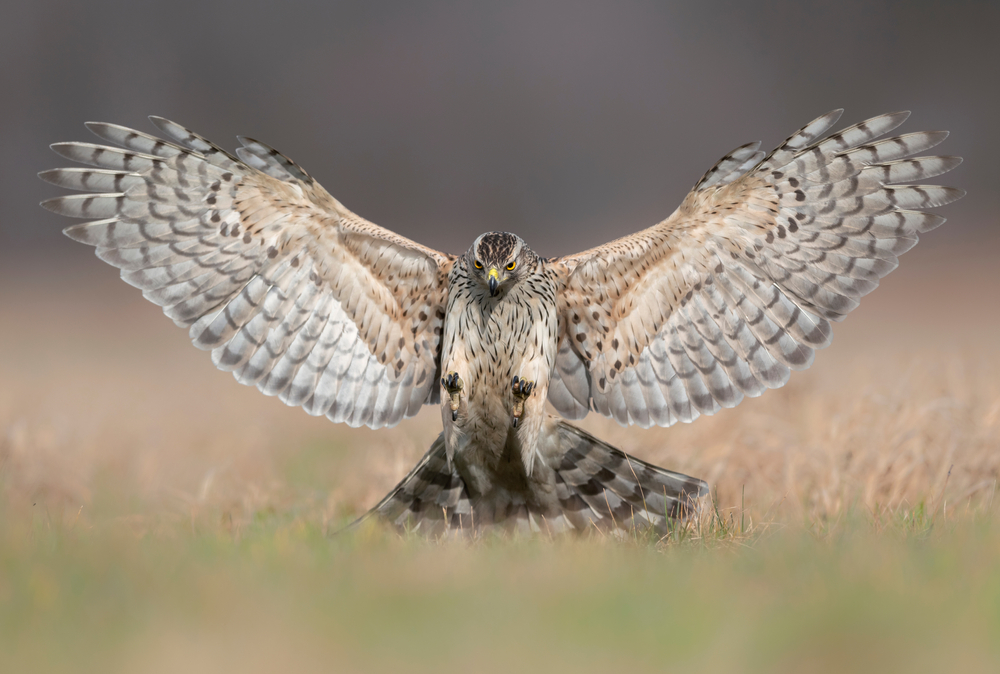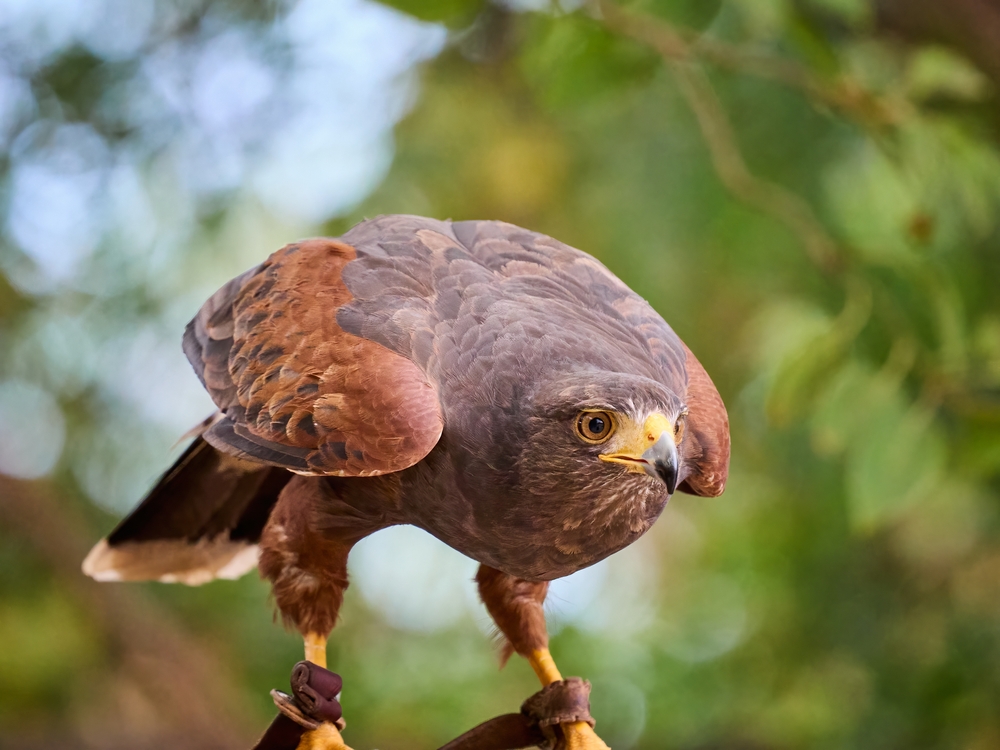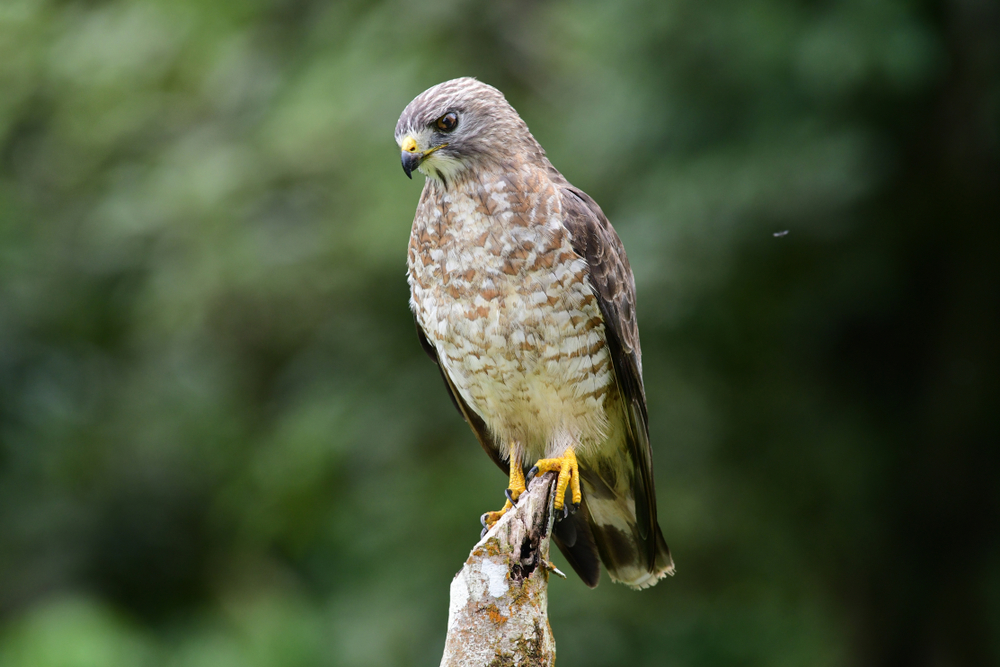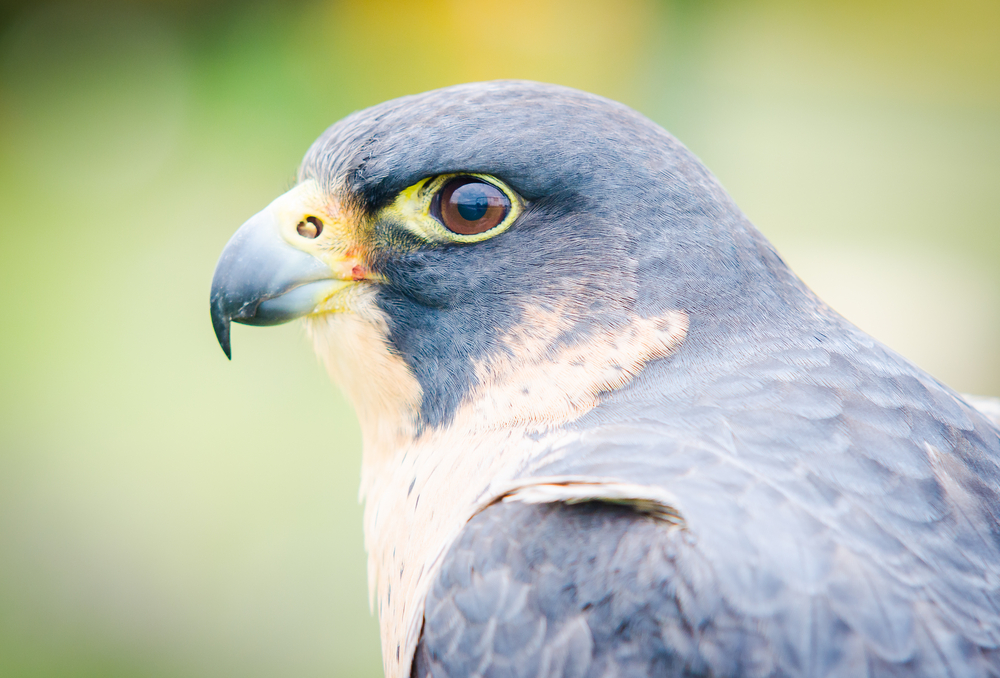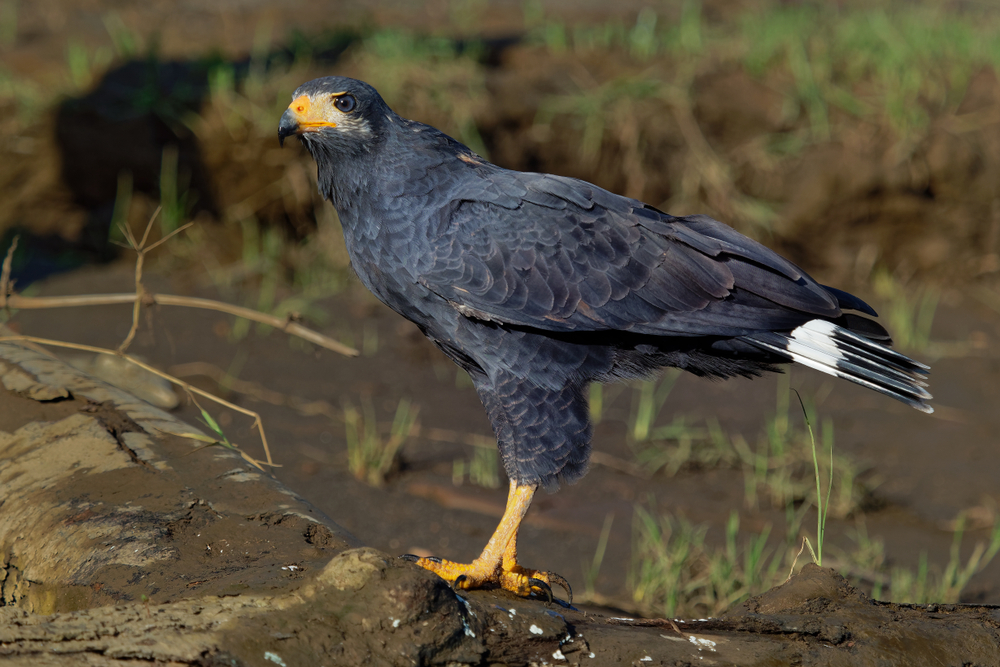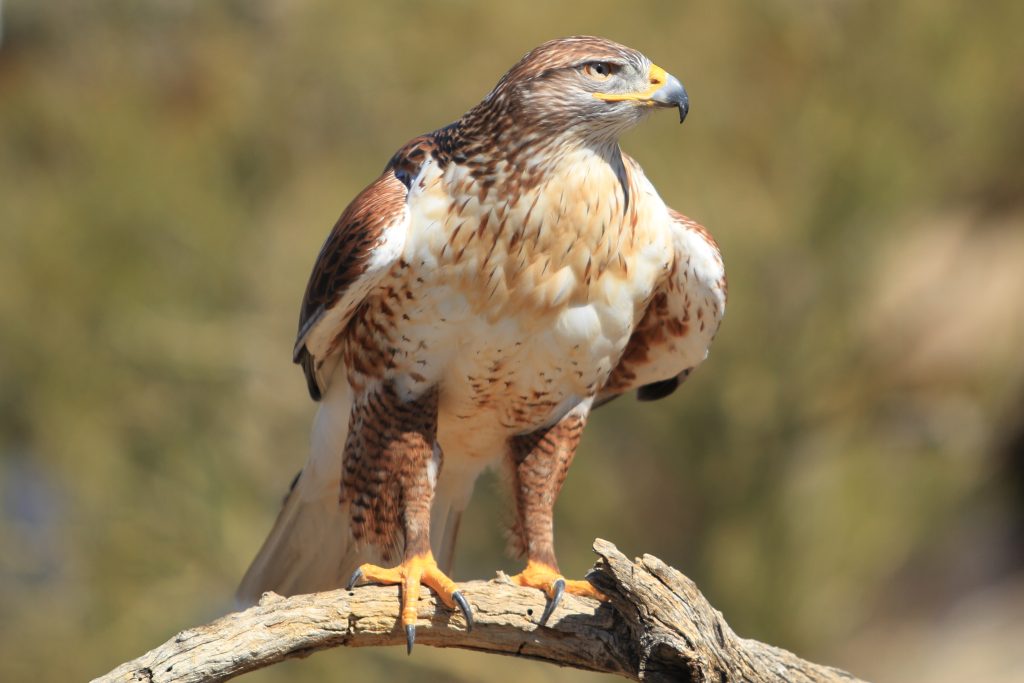The Northern Goshawk’s closest relatives are other Accipiter hawks, particularly the Eurasian Sparrowhawk (Accipiter nisus) and the Sharp-shinned Hawk (Accipiter striatus). They share similar forest-hunting adaptations but differ in size, with the goshawk being the largest and most powerful.
About
The Northern Goshawk (Accipiter gentilis) is a powerful bird of prey in the Accipitridae family, renowned for its speed, strength, and fierce hunting skills. Found across North America, Europe, and Asia, it inhabits mature forests and wooded regions, where its agility allows it to weave through dense trees in pursuit of prey. This wide distribution and adaptability have made the Northern Goshawk one of the most iconic forest raptors in the Northern Hemisphere.
Measuring 48 to 69 centimeters (19 to 27 inches) in length with a wingspan of 98 to 127 centimeters (38 to 50 inches), it is the largest of the true Accipiters. Adults have slate-gray upperparts, finely barred gray underparts, and striking red eyes framed by a bold white eyebrow stripe. Juveniles are brown above with streaked underparts and yellow eyes. Its long tail and rounded wings make it exceptionally maneuverable, while its size gives it formidable power.
The diet of the Northern Goshawk is diverse, including medium-sized birds such as grouse, pigeons, and crows, as well as mammals like rabbits, squirrels, and hares. It is an ambush predator, relying on bursts of speed and surprise attacks to overwhelm prey. Its hunting prowess and aggressive defense of nesting sites have earned it a reputation as one of the fiercest raptors.
Breeding occurs in forested habitats, with pairs constructing large stick nests high in trees. The female typically lays two to four eggs, and both parents guard and raise the chicks. Goshawks are highly territorial, especially during nesting, and will even attack humans who approach too closely.
Currently listed as Least Concern, the Northern Goshawk maintains strong populations globally, though habitat loss, persecution, and declines in prey have affected numbers in some regions.
Symbolizing power and wildness, the Northern Goshawk has long been celebrated in falconry and folklore as the quintessential forest hunter.
Physical Characteristics
The Northern Goshawk (Accipiter gentilis) is a large, powerful forest hawk, known for its fierce hunting style and striking plumage.
-
Plumage: Adults have slate-gray to blue-gray upperparts with finely barred gray-and-white underparts. Juveniles are brown above with heavy streaking below.
-
Face: The head is bold, with a dark cap and a distinctive white eyebrow stripe (supercilium) that gives the bird an intense, fierce look. Eyes are bright red in adults and yellow in younger birds.
-
Body: Stocky and muscular, with a broad chest and long body built for strength and speed.
-
Wings: Short, broad, and rounded—adapted for maneuvering quickly through dense forests.
-
Tail: Long and rounded with 3 to 5 dark bands, used for steering during rapid pursuits through trees.
-
Feet: Large and yellow, equipped with powerful talons designed for seizing and subduing medium-sized prey.
Size:
-
Length: About 20 to 26 in (50 to 66 cm).
-
Wingspan: Between 40 to 47 in (100 to 120 cm).
-
Weight: Ranges from 1.5 to 3.3 lbs (700 to 1,500 g), with females much larger than males.
The Northern Goshawk’s bold eyebrow stripe, powerful build, and forest-adapted wings and tail make it one of the most distinctive and formidable raptors in the Northern Hemisphere.
Reproduction
The reproductive cycle of the Northern Goshawk is adapted to its forested habitat, where tall trees provide nesting sites and abundant prey.
-
Mating and Courtship:
-
Northern Goshawks are generally monogamous, often maintaining long-term pair bonds.
-
Courtship includes spectacular aerial displays—dives, circling flights, and talon-grappling—as well as vocal calls.
-
Pairs often return to the same nesting territory each year.
-
-
Nesting:
-
Nests are built high in large coniferous or deciduous trees, usually 20–60 ft (6–18 m) above the ground.
-
Nests are large stick platforms, lined with bark, fresh greenery, and feathers.
-
Pairs may maintain multiple nests within their territory, alternating between them in different years.
-
-
Egg Laying and Incubation:
-
Females typically lay 2 to 4 eggs, bluish-white in color.
-
Incubation lasts 35 to 38 days, performed mostly by the female while the male provides food.
-
-
Chick Development:
-
Chicks hatch covered in white down and are brooded closely during their first two weeks.
-
The male delivers prey to the nest, and the female tears it into smaller pieces to feed the chicks.
-
-
Fledging and Independence:
-
Young fledge at about 35 to 42 days, but they remain dependent on the parents for food for another 4 to 6 weeks as they learn to hunt.
-
Northern Goshawks’ strong territoriality and intensive parental care ensure the survival of their chicks, but breeding success can fluctuate depending on prey availability in forest ecosystems.
Lifespan
The Northern Goshawk (Accipiter gentilis) is a fierce forest-dwelling raptor with a moderate lifespan influenced by hunting challenges, predation, and environmental conditions.
-
Lifespan in the Wild:
Northern Goshawks typically live 7 to 12 years in the wild, though some individuals may survive up to 15 to 20 years. Juvenile mortality is high, as many young do not survive their first year due to inexperience in hunting or predation. -
Lifespan in Captivity:
In falconry and wildlife care, goshawks may live longer, often reaching 20 years or more, thanks to consistent food, medical care, and protection from natural dangers.
Threats to the Northern Goshawk:
-
Predation: Eggs and nestlings are vulnerable to Great Horned Owls, ravens, and martens. Adults are occasionally preyed upon by larger raptors such as eagles.
-
Food Availability: Population success is closely tied to prey cycles (especially grouse, pigeons, and rabbits). Poor prey years reduce breeding success.
-
Human Impacts: Logging, habitat fragmentation, and disturbance near nest sites can reduce suitable breeding territories.
-
Hunting Hazards: Juveniles learning to hunt often collide with trees or suffer injuries during high-speed chases in dense forests.
Though widely distributed across the Northern Hemisphere, Northern Goshawk populations are sensitive to forest management practices, making conservation of mature forests essential to their long-term survival.
Eating Habits
The Northern Goshawk is a powerful forest hunter, specialized for speed and agility in dense woodlands.
-
Diet:
Their diet is dominated by medium-sized birds (such as grouse, pigeons, crows, and woodpeckers) and mammals(including rabbits, hares, and squirrels). They also take reptiles and large insects when available. -
Foraging Strategy:
Goshawks are ambush predators, using dense cover to conceal themselves before launching rapid chases through trees. Their short, rounded wings and long tail provide maneuverability for high-speed pursuit in tight spaces. -
Hunting Behavior:
They often hunt from a perch, scanning for prey before bursting into flight. Once locked onto a target, they pursue relentlessly, using sharp talons to strike and kill.
They are strong enough to subdue prey nearly equal to their own size. -
Feeding the Young:
The male delivers prey to the nest during the breeding season, while the female tears it into pieces to feed chicks. As young mature, whole prey is provided to develop hunting skills. -
Seasonal Variation:
Diet composition shifts with prey availability. In northern forests, snowshoe hares and grouse are staples, while in temperate zones, pigeons, jays, and squirrels may dominate.
The Northern Goshawk’s role as a top forest predator makes it vital to woodland ecosystems, where it helps regulate populations of birds and small mammals.
Uniqueness
The Northern Goshawk (Accipiter gentilis) is one of the most formidable woodland raptors, with several traits that make it stand out:
-
Forest Specialist: With short, rounded wings and a long tail, it is built for high-speed pursuits through dense forests—an agility few raptors can match.
-
Bold Eyebrow Stripe: Its striking white supercilium (eyebrow) gives it a fierce expression and is a key field mark distinguishing it from other hawks.
-
Aggressive Defender: Known for ferociously defending its nest, it will dive at and strike intruders—including humans—making it one of the most fearless raptors.
-
Widespread Range: Found across the Northern Hemisphere, from North America to Europe and Asia, it is one of the most broadly distributed accipiters in the world.
-
Prey Versatility: Capable of taking prey nearly its own size, from grouse and pigeons to hares and squirrels, showcasing exceptional strength and adaptability.
-
Cultural Symbol: Revered in falconry for centuries, goshawks symbolize power and wildness and are prized for their hunting skill.
The Northern Goshawk’s combination of speed, power, and fearless temperament makes it one of the most iconic and respected raptors of the northern forests.
Be the First to Share Photos of This Species.
FAQ’s
1. What is the species closest to the Northern Goshawk?
2. How does the Northern Goshawk compare to other hawks?
Northern Goshawks are larger and stronger than Cooper’s or Sharp-shinned Hawks, capable of taking much bigger prey. Unlike open-country buteos such as Red-tailed Hawks, goshawks are forest specialists, using short wings and long tails for agility. They are also more aggressive, known for fiercely defending their nests against intruders.
3. What national parks provide an opportunity to see the Northern Goshawk?
Northern Goshawks inhabit mature forests across North America and Eurasia. In the U.S., they may be seen in:
-
Denali National Park (Alaska) – boreal forest habitat.
-
Yellowstone National Park (Wyoming/Montana/Idaho) – forested areas with abundant prey.
-
Glacier National Park (Montana) – coniferous mountain forests.
-
Grand Canyon National Park (Arizona) – breeding pairs in forested rims.
These parks highlight the goshawk’s preference for large, intact forests.



































































